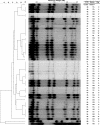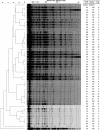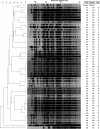Genetic relationships between Candida albicans strains isolated from dental plaque, trachea, and bronchoalveolar lavage fluid from mechanically ventilated intensive care unit patients - PubMed (original) (raw)
Genetic relationships between Candida albicans strains isolated from dental plaque, trachea, and bronchoalveolar lavage fluid from mechanically ventilated intensive care unit patients
Seok-Mo Heo et al. J Oral Microbiol. 2011.
Abstract
Candida albicans often resides in the oral cavity of healthy humans as a harmless commensal organism. This opportunistic fungus can cause significant disease in critically ill patients, such as those undergoing mechanical ventilation in the intensive care unit (ICU) having compromised local airway defense mechanisms. The goal of this study was to determine the intra- and inter-patient genetic relationship between strains of C. albicans recovered from dental plaque, tracheal secretions, and the lower airway by bronchoalveolar lavage of patients undergoing mechanical ventilation. Three pulsed-field gel electrophoresis (PFGE) typing methods were used to determine the genetic relatedness of the C. albicans strains, including electrophoretic karyotyping (EK) and restriction endonuclease analysis of the genome using SfiI (REAG-S) and BssHII (REAG-B). The C. albicans isolates from dental plaque and tracheo-bronchial sites from the same patient were genetically indistinguishable and retained over time, whereas strains from different patients usually separated into different genotypes. Among the three methods, REAG-B proved to be the most discriminatory method to differentiate isolates. The finding of genetically similar strains from the oral and tracheo-bronchial sites from the same patient supports the notion that the oral cavity may serve as an important source for C. albicans spread to the trachea and lung of mechanically ventilated patients.
Keywords: mechanical ventilation; molecular epidemiology; oral cavity; pulsed-field gel electrophoresis (PFGE); yeast.
Figures
Fig. 1
Electrophoretic karyotypes (EK) with dendrogram for Candida albicans isolates. A genetic similarity percentage is shown above the dendrogram. Patient identification (Pt ID), sample site (Source), and number of days after admission to the intensive care unit that the strain was isolated (Day) are included along each PFGE lane. Saccharomyces cerevisiae DNA concatemers were used as the molecular size marker. Sizes are measured in megabases (Mb). C. albicans strain SC5314 (ATCC MYA-2876) was used as the control strain. Abbreviations: SG, supragingival dental plaque; TS, tracheal secretion; BL, bronchoalveolar lavage.
Fig. 2
Pulsed-field gel electrophoresis (PFGE) patterns of _Sfi_I restriction endonuclease analysis of genomic DNA (REAG-S) with dendrogram for Candida albicans isolates. A genetic similarity percentage is shown above the dendrogram. Patient identification (Pt ID), sample site (Source), and number of days after admission to the intensive care unit that the strain was isolated (Day) are included along each PFGE lane. Saccharomyces cerevisiae DNA concatemers and λ DNA ladder were used as size markers. Sizes are measured in kilobases (Kb). C. albicans strain SC5314 (ATCC MYA-2876) was used as the control strain. Abbreviations: SG, supragingival dental plaque; TS, tracheal secretion; BL, bronchoalveolar lavage.
Fig. 3
Pulsed-field gel electrophoresis (PFGE) patterns of _Bss_HII restriction endonuclease analysis of genomic DNA (REAG-B) with dendrogram for Candida albicans isolates. A genetic similarity percentage is shown above the dendrogram. Patient identification (Pt ID), sample site (Source), and number of days after admission to the intensive care unit that the strain was isolated (Day) are included along each PFGE lane. Saccharomyces cerevisiae DNA concatemers and λ DNA ladder were used as size markers. Sizes are measured in kilobases (Kb). C. albicans strain SC5314 (ATCC MYA-2876) was used as the control strain. Abbreviations: SG, supragingival dental plaque; TS, tracheal secretion; BL, bronchoalveolar lavage.
Similar articles
- Genetic relationships between respiratory pathogens isolated from dental plaque and bronchoalveolar lavage fluid from patients in the intensive care unit undergoing mechanical ventilation.
Heo SM, Haase EM, Lesse AJ, Gill SR, Scannapieco FA. Heo SM, et al. Clin Infect Dis. 2008 Dec 15;47(12):1562-70. doi: 10.1086/593193. Clin Infect Dis. 2008. PMID: 18991508 Free PMC article. - Molecular investigation of two consecutive nosocomial clusters of Candida tropicalis candiduria using pulsed-field gel electrophoresis.
Rho J, Shin JH, Song JW, Park MR, Kee SJ, Jang SJ, Park YK, Suh SP, Ryang DW. Rho J, et al. J Microbiol. 2004 Jun;42(2):80-6. J Microbiol. 2004. PMID: 15357299 - The use of molecular techniques for epidemiologic typing of Candida species.
Pfaller MA. Pfaller MA. Curr Top Med Mycol. 1992;4:43-63. doi: 10.1007/978-1-4612-2762-5_2. Curr Top Med Mycol. 1992. PMID: 1732071 Review.
Cited by
- Periodontitis and Its Inflammatory Changes Linked to Various Systemic Diseases: A Review of Its Underlying Mechanisms.
Bhuyan R, Bhuyan SK, Mohanty JN, Das S, Juliana N, Juliana IF. Bhuyan R, et al. Biomedicines. 2022 Oct 21;10(10):2659. doi: 10.3390/biomedicines10102659. Biomedicines. 2022. PMID: 36289921 Free PMC article. Review. - Candida albicans Carriage in Children with Severe Early Childhood Caries (S-ECC) and Maternal Relatedness.
Xiao J, Moon Y, Li L, Rustchenko E, Wakabayashi H, Zhao X, Feng C, Gill SR, McLaren S, Malmstrom H, Ren Y, Quivey R, Koo H, Kopycka-Kedzierawski DT. Xiao J, et al. PLoS One. 2016 Oct 14;11(10):e0164242. doi: 10.1371/journal.pone.0164242. eCollection 2016. PLoS One. 2016. PMID: 27741258 Free PMC article. - Pediatric pulmonary infection caused by oral obligate anaerobes: Case Series.
Zhijun L, Wenhai Y, Peibin Z, Qingming L. Zhijun L, et al. Front Pediatr. 2023 Sep 1;11:1226706. doi: 10.3389/fped.2023.1226706. eCollection 2023. Front Pediatr. 2023. PMID: 37744449 Free PMC article. - Systematic review and meta-analysis of the antioxidant capacity of lycopene in the treatment of periodontal disease.
López-Valverde N, López-Valverde A, Macedo de Sousa B, Blanco Rueda JA. López-Valverde N, et al. Front Bioeng Biotechnol. 2024 Jan 8;11:1309851. doi: 10.3389/fbioe.2023.1309851. eCollection 2023. Front Bioeng Biotechnol. 2024. PMID: 38344076 Free PMC article. - Mobile microbiome: oral bacteria in extra-oral infections and inflammation.
Han YW, Wang X. Han YW, et al. J Dent Res. 2013 Jun;92(6):485-91. doi: 10.1177/0022034513487559. Epub 2013 Apr 26. J Dent Res. 2013. PMID: 23625375 Free PMC article. Review.
References
- Cutler JE. Putative virulence factors of Candida albicans. Annu Rev Microbiol. 1991;45:187–218. - PubMed
- McCullough MJ, Ross BC, Dwyer BD, Reade PC. Genotype and phenotype of oral Candida albicans from patients infected with the human immunodeficiency virus. Microbiology. 1994;140:1195–202. - PubMed
LinkOut - more resources
Full Text Sources
Research Materials


